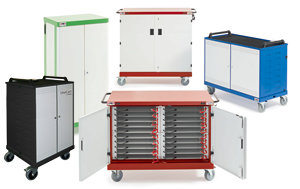
Laptops are fantastic learning tools, but it is no secret that mobile devices can pose issues for schools when it comes to managing and deploying equipment. Although laptop trolleys were created to resolve these problems, it is still important to have an action plan in place to get the most from your mobile ICT.
To make organising your school’s ICT equipment that little bit easier, I’ve put together some short tips on how to manage laptop trolleys and laptops in the classroom.

According to the latest ICT Provision and Use in Schools report by the British Educational Suppliers Association (BESA), the average UK secondary school has around 86 laptops. Even more extraordinarily, the same report holds that, of the 2.5 million computers currently used by pupils in UK schools, the majority of them are laptops.
With so many schools favouring portable computers, laptop storage and charging trolleys are now commonplace in our classroom, providing teachers will a fully mobile ICT suite that can be wheeled between rooms of pupils. Unfortunately, with the rise in popularity of laptop trolleys comes an entire field of associated jargon, making it very difficult to decide which laptop trolley best meets a school’s needs. To make things even more complicated, different manufacturers can often mean different things when they use a particular term.
To help make your decision a little easier, I thought I’d run through some of the most common, and most confusing, phrases, to provide some clarity.

A community-driven platform for showcasing the latest innovations and voices in schools
Pioneer House
North Road
Ellesmere Port
CH65 1AD
United Kingdom